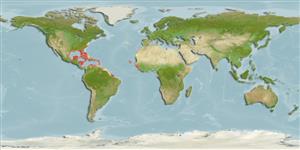>
Gobiiformes (Gobies) >
Gobiidae (Gobies) > Gobionellinae
Etymology: Gnatholepis: Greek, gnathos = jaw + Greek,lepis = scale (Ref. 45335).
Eponymy: Commander Joseph Cheesman ‘Snake’ Thompson (1874–1943) was a US Navy medical officer (retired 1929) and amateur herpetologist. [...] (Ref. 128868), visit book page.
More on author: Jordan.
Environment: milieu / climate zone / εύρος βάθους / distribution range
Οικολογία
Θαλασσινό(ά) Υφαλόφιλο(α); εύρος βάθους 0 - 50 m (Ref. 5299), usually 1 - 36 m (Ref. 92171). Tropical; 43°N - 2°S
Atlantic: southern Florida, North Carolina, the Bahamas, Bermuda through to the Lesser Antilles in western Atlantic; also in the oceanic islands of Ascension, Madeira and St Helena, and Sao Tome Island, Cape Verde Islands and the Canary Islands in the eastern Atlantic.
Μέγεθος / Βάρος / Age
Γεννητική Ωρίμανση: Lm ? range ? - ? cm
Max length : 8.2 cm TL αρσενικό/απροσδιόριστο; (Ref. 39517); 5.7 cm TL (female)
Ραχιαίες άκανθες (συνολικά) : 7; Μαλακές ραχιαίες ακτίνες (συνολικά) : 10 - 12; Εδρικές άκανθες: 1; Μαλακές εδρικές ακτίνες: 11. Distinguished by the following characteristics: moderately large Gnatholepis (up to 58 mm SL) with nape midline scales always cycloid and most of predorsal scales cycloid; body pale with 6-8 rows of staggered dark brown spots, mid-lateral spots may be largest; transverse black line on the upper part of the eye joining somewhat oblique to curved black line or bar crossing cheek and ending well behind end of jaw; third to fourth first dorsal fin spines longest, fin with square to rectangular appearance when extended; second dorsal and anal fin rays usually I,11; pectoral rays 16-18, usually 17; lateral scales 26-29, usually 27; 9-11 predorsal scales (usually 10), all cycloid (Ref. 92171).
Body shape (shape guide): fusiform / normal.
Inhabits open sand, rock, and rubble areas. Often occurs with the bridled goby, Coryphopterus glaucofraenum. Feeds on organisms and organic material by taking sand into its mouth and expelling it through the gill openings, filtering out its food in the process (Ref. 26938).
Life cycle and mating behavior
Γεννητική Ωρίμανση | Αναπαραγωγή | Γεννοβολία | Αβγά | Γονιμότητα | Προνύμφες
Robins, C.R. and G.C. Ray, 1986. A field guide to Atlantic coast fishes of North America. Houghton Mifflin Company, Boston, U.S.A. 354 p. (Ref. 7251)
IUCN Red List Status (Ref. 130435: Version 2025-1)
Threat to humans
Harmless
Human uses
αλιεία: Εμπορικό(ά); Ενυδρείο: Εμπορικό(ά)
Εργαλεία
Special reports
Download XML
Διαδικτυακές πηγές
Estimates based on models
Preferred temperature (Αναφ.
123201): 23.5 - 28, mean 26.5 °C (based on 290 cells).
Phylogenetic diversity index (Αναφ.
82804): PD
50 = 0.5010 [Uniqueness, from 0.5 = low to 2.0 = high].
Bayesian length-weight: a=0.00871 (0.00461 - 0.01646), b=3.19 (3.03 - 3.35), in cm total length, based on LWR estimates for this species & (Sub)family-body (Ref.
93245).
Τροφικό Επίπεδο (Αναφ.
69278): 2.3 ±0.2 se; based on diet studies.
Ελαστικότητα (Αναφ.
120179): Υψηλό, ελάχιστος χρόνος για διπλασιασμό πληθυσμού < 15 μήνες (Preliminary K or Fecundity.).
Fishing Vulnerability (Ref.
59153): Low vulnerability (10 of 100).
🛈
Nutrients (Ref.
124155): Calcium = 145 [76, 299] mg/100g; Iron = 0.966 [0.480, 1.800] mg/100g; Protein = 18 [16, 20] %; Omega3 = 0.145 [0.067, 0.263] g/100g; Selenium = 27 [14, 56] μg/100g; VitaminA = 110 [28, 389] μg/100g; Zinc = 2.52 [1.66, 3.76] mg/100g (wet weight);
